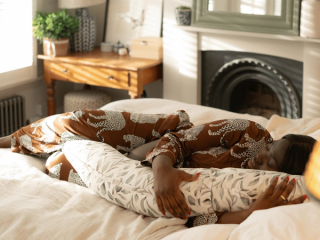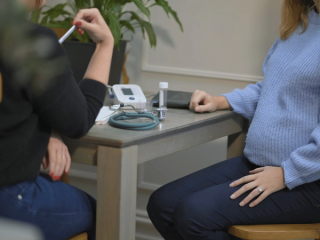
- Home
- Advice And Support
- Pregnancy
- Pregnancy Care
- Exercise In Pregnancy
Exercise in Pregnancy
Find out more about which exercises are safe to do in pregnancy and what exercises to avoid.
Staying active, fit and strong during your pregnancy can offer numerous benefits, including improved mood, increased energy levels, and better preparation for birth. Of course, pregnancy can bring with it lots of unwanted symptoms, some of which make exercising more difficult but there are so many symptoms such as back ache, exhaustion, nausea that exercise can help with. If done correctly, and the right type of exercise is chosen, you can find that exercise really can help you to feel great throughout your pregnancy. It is important that you find a type of exercise that you enjoy doing and feel comfortable doing, because you are far more likely to stick at it and the good thing is that there are lots of options to choose from.
Which Exercises Are Safe During Pregnancy?
Contrary to popular belief, there is actually far more that you can do when it comes to exercise in pregnancy, than you can’t do. It is important to know the things that you need to stay away from to make sure that you are keeping your baby safe in that bump.
Things you will want to avoid in pregnancy is overheating. Your baby isn’t able to control their body temperature in the womb so it is up to us to do it for them so exercising in the midday heat in a hot country, or going in a sauna is a no no for now. Lying on your back for prolonged periods is also something to avoid, as this can compress vital veins and arteries that bring fresh oxygenated blood to and from the baby. You also want to avoid doing any sports or activity where you are likely to fall or be knocked into so contact sports are not advised in pregnancy.
Aside from the above, throughout your pregnancy it is important for you to pay attention to what feels good for your body. Something may be “safe” but if it doesn’t feel good for you then that is a sign to either adapt it or to choose something else for now.
Here are some things you might want to try.
Walking
A great, and underrated way of staying active. It can be done at any pace and is easy to fit into your daily routine. It also is a huge mood booster just to get out in the fresh air so it’s a win win for both physical and mental health.
Swimming
The buoyancy of water alleviates pressure on your joints, making swimming an excellent full-body but low impact workout, especially in the latter phases of pregnancy. It feels nice on your joints just being in the water, let alone swimming!
Indoor and outdoor cycling
This is a low-impact option that helps improve cardiovascular fitness while being gentle on your joints. In early pregnancy, if you are feeling comfortable and safe on a bike then you can take gentle cycles outdoors. Spin classes are well known for boosting endorphins with the fun playlists and community feel so can be great for the mood too and much safer as you progress through your pregnancy as there is less chance of falling.
Yoga
Prenatal yoga can enhance flexibility, reduce stress, and promote relaxation, making it an excellent choice for pregnant women. You can do it anywhere too, which makes it very accessible for everyone.
Pilates
This is such a beneficial form of exercise in pregnancy, it’s kind on your joints which is so important in pregnancy. Pilates specifically targets those all-important muscles that we need to remain strong as our posture changes in pregnancy. Whether it is mat based or on a reformer it is important that you ensure the exercises you are doing are pregnancy safe. Your instructor can advise you on this as you progress through your pregnancy.
Pelvic Floor Exercises
Pelvic floor exercises, often referred to, but not limited to Kegel exercises, are essential for women at any stage of their life, but particularly beneficial during pregnancy. They can be done in isolation, or within other types of exercise and the more we do them the better.
If you imagine your pelvic floor as the hammock that holds all your pelvic organs in place, you can see why it gets put under a lot of pressure as your baby grows. It is vital that we maintain it’s strength during and after pregnancy.
There are many ways to engage and strengthen your pelvic floor, but it is also incredibly important to learn how to relax it too. Just like any muscle in our body if it is tense all the time it’ll tire out and become weaker.
To perform a simple Kegel exercise, or a pelvic floor “squeeze”, it’s important to remember the connection between the pelvic floor, breath and our core to avoid working them in isolation. They can be done in lying, seated or standing positions. Start by lying to begin with and as you exhale gently lift your pelvic floor muscles as if you were holding in wind, then as you inhale feel yourself relaxing all your muscles and letting go. You can practice this with a hold at the top of the movement, and work on holding for 5 seconds and doing 5 -10 repetitions of this but it does take time to get used to it so be patient with yourself.
A stronger pelvic floor can help you return to exercises like lifting weights, running or jumping without any feelings of heaviness, dragging, or leaking. Doing this will also translate into your everyday life too so really worth taking the time to work on it. Just a few minutes every day can really make all the difference.
Outdoor Exercises
Getting outside is absolutely essential for both physical and mental health. During pregnancy when your hormones can feel all over the place, it can do wonders for your mood to get out in the fresh air no matter what the weather is like. You can go for a walk, a jog, or simply take a resistance band to the local park for your workout. Keeping it simple is such a brilliant way to motivate yourself to keep it up.
Gardening or dancing round your kitchen
Your exercise doesn’t have to be a “workout”, sometimes just being active in and around the house can be just what you need to be less sedentary. If you’ve got other children, playing in the garden or singing and dancing in the kitchen can raise your heart rate and get your body moving in the perfect way.
Pregnancy Exercises at Home
Exercising at home is a brilliant way to combat lack of time, confidence or perhaps motivation as you can do it right in your living room wearing your pyjamas if you want to, knowing that no one is watching. You can do so much with absolutely no equipment whatsoever but things like dumbbells, resistance bands and the pregnancy ball can add some variety to your workout. You can do squats, lunges, core work and a multitude of exercises using just these pieces of equipment.
There are also lots of online classes you can follow along with at home, or create your own workout but it is important that it is suitable for pregnancy. Ask your health care professional if you are unsure of its suitability for you during your pregnancy.
Pregnancy ball
If you have a pregnancy ball at home, this can be a really good tool for exercising with a bump. It is essentially a large blown-up ball that you can easily get from any sports shop. Make sure it is anti-burst and that it is big enough for there to be a 90-degree angle at the knees.
You can use the ball to help with your balance when doing things like squats by placing it behind your back against a wall as you go up and down into the movement. You can also use it to sit on as you perform upper body exercises such as shoulder press or bicep curls. The benefit of having a pregnancy ball is it’s diversity of use, you can also use it for lots of lovely stretches.
Stretches to do with a pregnancy ball
Many women complain of back ache in pregnancy and there are a few stretches you can do using the ball that will really help to alleviate this.
Overhead kneeling stretch
- Place the ball in front of you while you are kneeling with your knees hip width apart or wider.
- Roll the ball out keeping your arms straight
- Drop your head down in between your arms to encourage a lovely stretch down your spine
- You can sway gently side to side to enhance the stretch
Seated Lateral twists
- Sitting on the ball with your feet nice and wide for stability
- Place one hand on the side of the ball
- Use the other hand to reach up and over your head leaning over
- Feel the stretch in the side of your body and take a few deep breaths here
- Gently return to the middle and switch sides to repeat the same movement
Pelvic tilts
- Sitting on the ball with your feet wide and your hands on your hips
- Use the ball to help you tuck your tailbone under to create a lower back stretch
- Then reverse this movement by bringing your tailbone in the opposite direction to create a small arch in your back
- Go back and forth on these a few times
Hip circles
- As with the pelvic tilts, place your hands on your hips
- Draw a figure of 8 with your hips using the ball to guide the movement.
Exercises to do with a pregnancy ball
There are lots of wonderful exercises that you can do at home with no equipment whatsoever such as squats, lunges, press ups, glute bridges, and lots for your core as well. Here are a few examples.
Four point kneeling
- Start off in a kneeling position with your hands and knees equal distance apart
- Gently exhale as you bring your abdominals up towards your belly button, without sucking your tummy in.
- Hold it for a few seconds (if you feel like you can, you can lift your knees off the ground a few cm here)
- Return to your original position on your inhale
Plank shoulder taps
- In an adapted plank position with your knees on the ground, make sure your knees are hip width apart and your shoulders are over your hands.
- As you exhale take one hand off the floor and tap the opposite shoulder
- Inhale as you bring it back down
- Repeat on the other side
Side plank dips
- Lying on your side, use your forearm to balance you
- Bend the leg closest to the ground and keep the top one straight
- Use the knee on the ground to push into as you lift your hips up
- Hold this position for 2 seconds
- Dip your hip down so it gently touches the floor
- Repeat
Sofa hip thrusts
- Sit down in front of your sofa with your back against the sofa
- Making sure your bra strap area is against the sofa, lift your hips up pushing into your feet for stability.
- Squeeze the glutes at the top of this movement, ensuring your spine is in a nice neutral position
- Lower back down to a seated position gently
- Repeat
I really want you to remember that exercising should not be feared in pregnancy. I know your body feels different and it can feel a bit daunting at times but exercising in whatever way feels good for you will hugely benefit you and your baby. If you are unsure of anything at all, always ask for advice from a prenatal qualified trainer or coach, or you can always reach out to me over Instagram at @bumpsandburpees and I will be more than happy to answer any questions that you may have.







